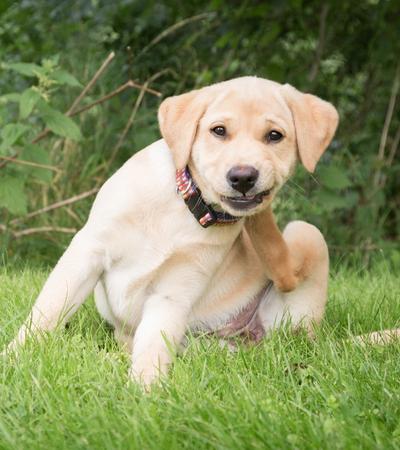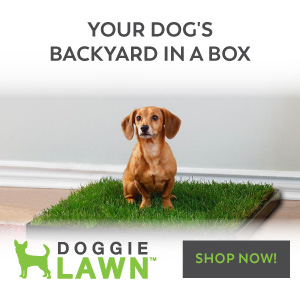If you have a dog then you will likely have some experience of dealing with fleas. These pesky parasites bite your bow-wow and feast on their blood. As well as being an itchy inconvenience for your pooch, fleas can also trigger an allergic reaction.
Flea bite allergies can cause unpleasant symptoms but, fortunately for your furry friend, there are ways to treat flea allergy in dogs.
In this article, we cover everything you need to know about flea bite allergies in dogs. Keep reading to learn how to tell if your pooch has fleas, the symptoms, and how to treat flea allergy dermatitis in dogs.
Fleas are the arch-nemesis of all pets and their owners. However, your dog’s pest problem won’t go unnoticed for long, as there are many obvious signs that your pet is hosting bow-wow beasties.
- Scratching — This is one of the most obvious signs that your dog has fleas. If you notice your pooch is scratching themselves a lot more than usual, chances are fleas are to blame.
- Biting/Gnawing — Sometimes to relieve the itching, dogs will bite their skin. When a flea bites, its saliva irritates the skin, and this can cause an itching sensation.
- Hair loss — If your dog’s hair is shedding and there are no other medical reasons to explain why, they likely have a flea infestation. Hair loss is often caused by excessive scratching and biting, but some species of flea can induce hair and fur loss.
- Pale gums — As fleas feed on your pet’s blood, your pooch can become at risk of developing anemia. If your dog has anemia, their gums won’t be a pink color, they will be paler than usual, even white and your canine companion may seem more lethargic than usual. Pale gums could be a sign your dog has a serious flea infestation that requires urgent attention.
- Red skin — Flea bites can leave red bumps on your dog’s skin, and sore welts can appear in more severe cases.
- Bites on your skin — Fleas aren’t fussy about what species they are biting! If your dog has fleas, it’s likely they’re in your carpet and anywhere your dog has been. If fleas are infesting your home, it’s only a matter of time before you get bitten too. If you notice bite marks on your feet, around your ankles, and the bottom half of your legs, it’s worth checking your dog for fleas.
As you can see, it isn’t hard to spot when your dog has unwanted guests, even though these bugs are minute! However, fleas can pose further problems if your tail-wagger is allergic to them.

Dogs can develop allergies to their food, in the environment, and our four-legged friends can be allergic to other animals and insects too — even fleas.
Flea allergy dermatitis in dogs is caused by the flea’s saliva. When a flea bites, the protein in the insect’s saliva can trigger a reaction. Some dogs aren’t affected, whereas others can suffer many painful and uncomfortable symptoms.
If you’re wondering how to tell if your dog is allergic to fleas, here’s a list of the common symptoms.
- Excessive scratching — Flea bite saliva is irritating to most dogs’ skin and causes them to scratch more than usual. However, intensive and prolonged scratching is a common sign of dog flea allergy dermatitis. In fact, some pooches may still be scratching a bite site two weeks after the flea actually bit them.
- Hair loss — While a flea infestation can cause hair loss, so can a dog allergy to flea bites. They may lose a lot of hair, particularly in the areas where they were bitten.
- Red rash — Your fur-baby may develop a red rash on their legs, tail area, or stomach. A flea allergy on dogs can cause skin rashes that may bleed or welt, and it’s not unusual for this to look raw and irritated.
- Constant biting — Like scratching, biting the site of a flea bite is normal canine behavior, they do so to try and relieve the itching sensation. However, if your dog is constantly gnawing, nibbling, or licking their own skin without any signs of relief, it’s worth getting them tested.
Flea bite allergies typically arise when a dog is between two and 5 years old. What’s more, pooches that suffer from other allergies — such as food allergies, dust allergies, etc. — are more susceptible to dog flea allergy dermatitis.
Diagnosis is confirmed — or ruled out — via blood or intradermal testing and an examination by your vet. However, these tests may not always be necessary as the symptoms of flea allergies in dogs are very easy to spot and confirm.

If you’re thinking, ‘my dog is allergic to fleas, what can I do?’ Try not to worry, your furry friend is going to be fine. There is more than one flea bite allergy treatment for dogs available, and working with a veterinarian, you’ll be able to find a suitable solution.
The number one priority is to avoid exposure to the allergen — meaning you need to de-flea your furry friend and keep to a strict flea-free regime.
- Regularly using an oral or topical flea treatment can help to kill and prevent fleas from breeding and causing an infestation.
- Fleas are more prolific throughout the summer months, yet it’s essential to stick to your de-flea schedule throughout the year.
Prevention is key, but while there are fleas in the world there is always a risk of your pooch being bitten, triggering an allergic reaction. Here is a list of typical treatments your vet may prescribe for a dog flea allergy:
- Desensitization — Desensitization (or hyposensitization) is the process of injecting a dog with increasing doses of a diluted flea antigen. This treatment is administered over a long period of time. The purpose of this is to reduce the severity of an allergic reaction in the future. However, desensitization doesn’t have a very high success rate, compared to other allergens.
- Corticosteroids — Steroids are one of the more common drugs used to treat sudden and severe episodes of flea bite allergies in dogs. Cortisone can offer rapid relief from extreme itching and is often used for short-term treatment.
- Antihistamines — This medication is often given alongside Corticosteroids as it also alleviates allergy symptoms.
- Antibiotics — Intense scratching may cause your dog to develop a secondary skin infection. It’s very easy for sore and inflamed skin to become infected, and your pooch may need a course of antibiotics to treat this condition.
Topical treatment — Your vet may advise using a dog shampoo or cream formulated to help ease the itching and irritation caused by flea allergy dermatitis.
Flea allergy dermatitis can really impact your dog’s mood and general demeanor. While they are suffering from their symptoms, your playful pooch may temporarily change into a grumpy and miserable mutt. Hence, if you want to cheer up your canine companion without the use of conventional medication there are many home remedies for flea allergy dermatitis in dogs to try:
- Sprinkle herbs into your dog’s coat. Some doggy parents claim eucalyptus, fennel, rosemary, and yellow dock helps to relieve itching and prevent fleas from biting. Crush and mix these herbs together, and sprinkle onto your dog’s fur several times a week.
- Give your dog a cold water bath. Cold water can help to instantly ease the pain of severe itchiness. And, a bath may wash some fleas out of your dog’s coat.
- Apply liquid witch hazel to your dog’s skin. You can buy bottles of witch hazel from most drugstores, and all you need to do is apply the liquid to your dog’s irritated skin. Witch hazel helps to relieve itching, soothe sore skin, and calm inflammation.
- Groom your dog with a flea comb. Regular grooming can help you to keep fleas at bay and also remove any eggs. Using a flea comb daily and regularly washing your dog with flea shampoo should help to evict the bugs and, in turn, reduce the risk of your dog suffering an allergic reaction.
However, while one tail-wagger may respond well to a home remedy, this approach may be completely unsuitable for another. Hence, seek advice from a vet when considering using a DIY remedy.

Conclusion
Fleas may be small in size, but they can be a big irritation to our four-legged friends — particularly if your dog is allergic to fleas. Signs include excessive biting and scratching, and your bow-wow’s skin may become sore and irritated.
Thankfully a flea allergy in dogs is straightforward to diagnose. It’s also both treatable and can be minimized with proper care and awareness.
“What Relieves Flea Allergy Dermatitis?”
You can soothe flea allergy dermatitis by giving your dog a cold bath. Many herbs can also alleviate extreme itching and help to reduce inflammation and irritation. If you’re looking for a flea allergy dermatitis dog’s home remedy, we’ve suggested a few you could try above.
“How Can I Tell if My Dog Has a Flea Allergy?”
A dog with a flea allergy will be extremely itchy, and they will excessively scratch and gnaw their skin. You may also notice red bumps and pink patches on their body, and parts may also become irritated and bleed. A flea allergy in dogs can also result in hair loss, particularly around the tail and along the hind legs.
“How Do I Treat My Dog’s Flea Allergy Scabs?”
Use a specially formulated shampoo, balm, or cream. Applying a topical treatment to your dog’s scabs can help to reduce inflammation and ease your dog’s urge to scratch. For more information, check out our Dog Shampoo for Allergies guide.
“Can a Dog Take Benadryl for Itching?”
You can, but this isn’t a long-term solution. Benadryl can help reduce swelling and inflammation caused by a flea bite and excessive scratching. However, be sure to do thorough research before giving your dog Benadryl to make sure you get the dosage right.
“How Can I Treat My Dog’s Flea Allergy Dermatitis at Home?”
In order to reduce any irritation or itching that is a result of flea bites, you could try a home remedy using white vinegar. Mixing one measure of white vinegar with the same measure of water and then applying where needed can offer your dog some relief, even if only temporarily.
“How Long Does It Take for Flea Allergy Dermatitis To Clear Up?”
Ensuring that all animals within the household are treated is the first important factor. This should, with time, lead to the elimination of all fleas. However, it can take a few months to completely eradicate the bugs due to their lifecycle.


